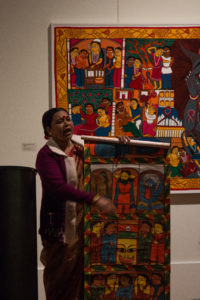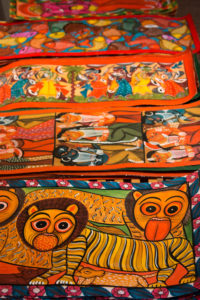By Hallela Hinton-Williams
hintonwi@grinnell.edu
Artist Swarna Chitrakar impressed the Grinnell College community with beautiful singing and descriptive and stunning artwork during her gallery talk on Wednesday, Oct. 4 in the Faulconer Gallery. The event was the latest in a series of talks held in Faulconer’s current exhibition, “Many Visions, Many Versions,” which features contemporary indigenous Indian art.
The audience got a small taste of her work, which utilizes the art form “patachitra,” a unique folk tradition of storytelling. Patachitra consists of beautifully painted scrolls accompanied by songs to describe the scene, a long tradition in India. The painters, known as Chitrakars or Patuas, travel with the pata, or cloth paintings, and perform the story and song to other villages.
The work is “the beginning of modern animation,” Chitrakar related through translator Suravi Sarkar.
Traditionally, the stories are mythological tales about Ramayana, Mahabharata and Mangal Kavyas, among many more. After being advised to terminate the pregnancy of her child in case it was a girl in her personal life, Chitrakar decided to integrate women’s rights, social issues and symbols of woman’s power into her work. She also has scrolls dealing with the tsunami and HIV.
“I like to paint the Hindu goddess Durga. Durga has the power to protect people and their children. She is an idol for many Bengalis. It is a symbol of embalmment,” Chitrakar said.
Chitrakar began this tradition at a young age by helping her father, another Patua, with the sight part of the scroll. When her father would take a break, Chitrakar would mix the colors and fill the figures in. Helping her father shaped Chitrakar into an impressive Patua and allowed her to prevent “patachitra” from declining. The stories are recounted only orally, so, for a bit of time, “patachitra” was a revivalist art form.
“The younger generation didn’t want to pursue this art form because of less exposure and decrease in compensation. But since 2004, there has been an intervention of various organizations, such as Banglanatak, and galleries that have turned it to a living tradition.” Chitrakar said.
This living tradition needs to be sustained for a lot longer. Without people to take up “patachitra,” a significant part of a culture could be lost.
As Sarkar related about Chitrakar, “It’s not her story, but the story of her village.”
To leave a legacy is why Chitrakar is training her five daughters and teaching the younger adults and children of her village. She also participates in residencies at colleges to teach students about the mythological stories and the process of “patachitra.”
Chitrakar and other Patuas in the village Pingla host a festival, POT Maya, that allows tourists, fellow artists and community members to interact with artists, learn how to extract natural colors and visit the community museum, the Folk Art Centre.
Learn more about Swarna Chitrakar, scroll painting and storytelling at Fall Fest, this Saturday Oct. 7, from 1 to 3:30 p.m. “Many Visions, Many Versions,” which features Swarna’s work along with twenty-four other artists, will be on display in Faulconer Gallery until Dec. 10.


Photo by Helena Gruensteidl
























































